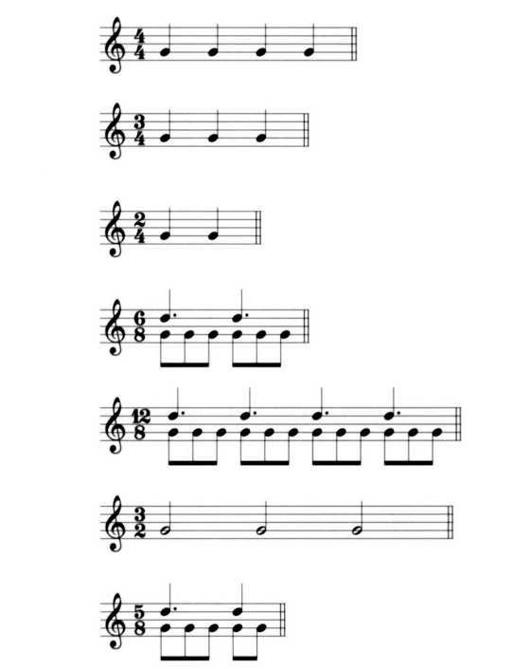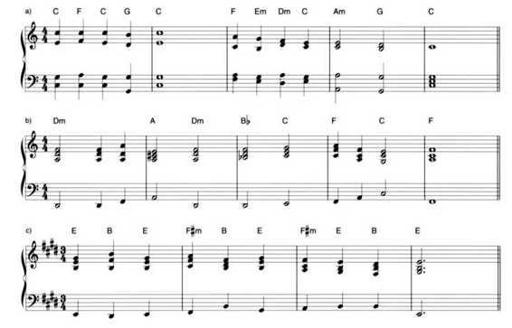A Player's Guide to Chords and Harmony (13 page)
Read A Player's Guide to Chords and Harmony Online
Authors: Jim Aikin

Most often, the rhythmic unit that lasts for one beat is the quarter-note. Other note values, such as the eighth-note, half-note, and dotted quarter-note, are sometimes used as the basic unit of the beat, but these are not often used except in classical music.
The grouping of beats into measures is called the meter. The word "meter" comes, in fact, from a Greek root that means "measure:" The meter of a piece of music is indicated by its time signature, which is shown on sheet music as two numbers, one above the other, at the left end of the first staff. The bottom number indicates which note value (quarter-note, eighth-note, etc.) is used for the beat, and the top number shows how many beats are in each measure. Even if these ideas were entirely new to you, from the information above you'd quickly be able to figure out that the most commonly used time signatures are 4/4 (four quarter-notes in each measure) and 3/4 (three quarter-notes in each measure). Some other useful time signatures are shown in Figure 4-1.
Time signatures are generally shown in text with a slash mark (/). However, they're not fractions.

Figure 4-1. A few of the meters commonly used in popular and classical music. In 6/8, 12/8, and 5/8 time, the time signature indicates that the eighth-note is the rhythmic unit that receives the beat. But in meters that have more than four beats to the bar, the units that receive the beat are generally grouped into units of two or three beats each. In effect, the measure is subdivided into a smaller number of chunks. 6/8 is generally subdivided into two units, each a dotted quarter-note (three eighth-notes) in length. In 12/8, there are four dotted quarter subdivisions. In 5/8 or 5/4 meter, the subdivisions are of unequal length: A bar with five beats is felt as consisting of either three beats followed by two, or two beats followed by three.
ASSIGNING CHORDS TO MEASURES & BEATS
In many pieces of music, when the chord that's being used changes, it always does so at the beginning of a new measure - at the bar line. This is more or less the norm, but it's by no means a universal. In some pieces, there are two chords per measure, or even a different chord on every beat. Going the other direction, it's quite common to see pieces in which a single chord lasts for two measures or even longer. Less often, but often enough to be worth knowing about, a new chord begins on the beat before the bar line and continues in the new bar. Quite often, you'll see all of the above in different sections of the same piece.
The timing of the chord changes in a piece is called its harmonic rhythm. If there's always a new chord in every bar, the piece has a steady harmonic rhythm. If, on the other hand, a single chord lasts for four measures in the first section of the piece, while in the second section of the same piece a new chord falls on every beat within the bar, the chords change more quickly in the second section, so we'd say the second section has a faster harmonic rhythm.
Using the chord voicing possibilities suggested in Chapter Three, we can begin to construct some simple keyboard parts that follow chord progressions. Figure 4-2 shows one possibility; Figures 4-15 and 4-16 show two others. The progressions shown in Figure 4-3 are a bit more interesting than the one in Figure 4-2, and again they use only triadic chords. We could construct thousands of other examples like these using only the ideas presented so far in this book. After a while they'd all start to sound similar, though. Throwing in a few more complex chords of the types shown later in this book will give a chord progression more spice.
If you play much popular music, sooner or later you're going to find yourself staring at a chord chart (see Figure 4-4). A chord chart shows the harmonic rhythm of the music, but neither the chord voicings nor the melody is notated. It's up to the performers to choose appropriate parts to play, using the progression in the chart as a guide. A full discussion of how to construct your own part from a chord chart would be far beyond the scope of this book, but we'll touch on it from time to time. If you're playing bass, you'll usually play the root of each chord in the indicated rhythm. If you're playing a chording instrument such as guitar or keyboard, you'll more likely play full chord voicings in a rhythm that fits with the style of the music. The bass, guitar, and keyboards can all play from the same chord chart, yet each will play a different part, because the parts to be played are not specified in the chart. Only the bare harmonic skeleton is provided.

Figure 4-2. A simple four-bar chord progression.

Figure 4-3. Three original chord progressions that use only triads. The chord symbols above the treble staff show the progression. As you play or listen to these progressions, try to determine which of the voicings are inversions. Also, analyze the harmonic rhythm. You'll find that some chords last for an entire measure, while other measures contain two, three, or four chords. Note that in (b), the chord voicing sometimes moves even though the underlying chord (as indicated by the chord symbol) isn't changing.

Figure 4-4. A four-bar excerpt from a chord chart. In a chord chart, neither the melody nor the chord voicings is indicated, only the chord types and the harmonic rhythm. Each slash-mark indicates a quarter-note duration. In bar 3 here, a G chord is to be played for two beats, followed by a D chord for two beats.
CHOOSING CHORDS BY THE NUMBERS
In Chapter Three, I introduced the diatonic triads that are found in a major scale. Not surprisingly, some or all of these triads are used in many or most chord progressions. They're used so often that musicians have developed a shorthand way of referring to them using numbers. Because this system developed some hundreds of years ago, it was usual to use Roman numerals when referring to diatonic triads. (The same numbering system is used by musicians in Nashville, but they no longer use Roman numerals.) The diatonic triads in a given key are referred to as the I, II, III, IV, V, VI, and VII chords, as shown in Figure 4-5.
Some musicians prefer to use lower-case Roman numerals to indicate the minor diatonic triads (ii, iii, and vi). This system is somewhat useful, in that it allows you to indicate quickly the difference between a ii chord (which is minor) and a II (which is major, although it's not a diatonic triad because the 3rd is an altered scale step). However, the upper/lowercase system is not universally employed. If you see the notation II or III, you can't be certain that whoever wrote it meant you to play a major chord.
Occasionally you'll see this numbering system extended to refer to chords whose roots are not in the diatonic scale. A 6VI chord, for instance, is one whose root is on the lowered 6th degree of the scale (A6 in the key of C), and so on. This system has an inherent weakness when it comes to verbal communication, however. Some of the chords we'll discuss later in this book include a flatted 5th, and are called "flat-five" (65) chords. A 65 chord is not the same thing as a 6V chord. One is a triad with a lowered 5th, and the other is a chord built on the flatted 5th step of the scale. But in most situations, it will be clear from the context which type of chord the speaker is referring to.
The practice of referring to chords by number is very commonly used. Improvising musicians talk routinely about various sorts of II-V progressions, for instance. If a musician says to you, "That's a two-five in the key of B6," he or she is talking about a progression in which some variety of C chord (the II in the key of B6) is followed by some variety of F chord (the V in B6).
We humans have a penchant for giving names to things, so maybe it's not surprising that there's another whole set of terminology that can be used to refer to the same group of diatonic chords. As Figure 4-6 shows, each note (scale step or chord root) in the major scale has a name. The I note/chord we've already seen referred to as the tonic, but the other terms are new.

Figure 4-5. The diatonic triads in a given key are often referred to using Roman numerals. Purely for the sake of variety, this example is given in the key of E.

Figure 4-6. The scale steps also have names, as shown here for the key of C major.
The most important terms in Figure 4-6 are "dominant" and "subdominant," for reasons discussed in the next section. The term "leading tone" is also important, but for slightly different reasons. The terms "supertonic," "mediant," and "submediant" are rarely heard outside of music theory classrooms.
